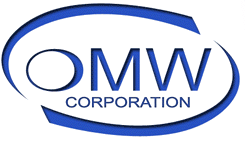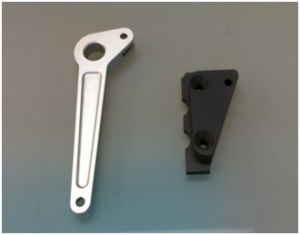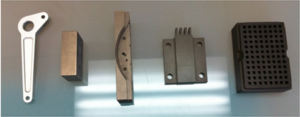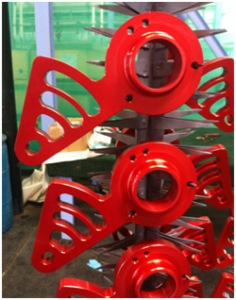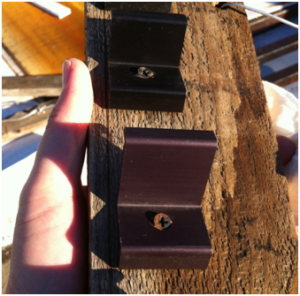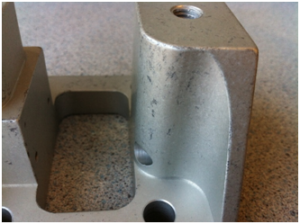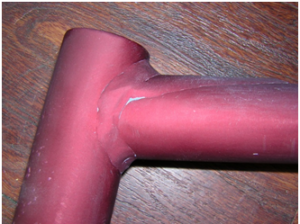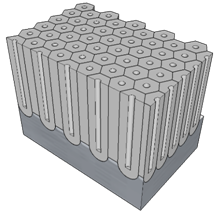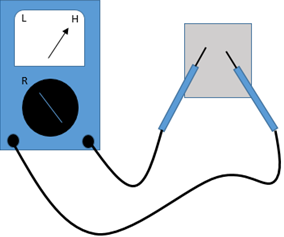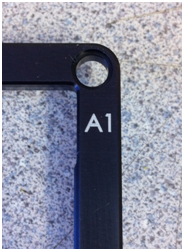What a Manufacturer Needs to Know…
By Joe Osborn, Founder, OMW Corporation (www.omwcorp.com), and Adjunct Faculty Member in Metals Technology at the College of Marin.
Copyright (C) 2006. All rights reserved. Illustrations by the author except as noted.
(Please note: Feedback is welcome and appreciated! Email Joe Osborn directly at jhko@aol.com)
For a .PDF version of this e-booklet, click here.
Why Anodizing?
Anodizing is perhaps the most commonly specified finish for aluminum machined parts. Advantages of Anodizing include:
- A very thin coating (.0002-.0012″ for Type II) compared to paints and powder coat. Coating thickness can often be ignored for machined parts.
- Extremely durable, hard, abrasion resistant and long lasting. Coating does not peel or chip. Much, much harder surface than paint (harder than tool steel). Coating lasts indefinitely.
- Some types (e.g., architectural anodizing) have colors which are fade resistant in sunlight nearly indefinitely.
- Excellent corrosion protection. Withstands salt-spray and other tests extremely well.
- Environmentally friendly finish. Can be readily recycled. Production involves simple inorganic chemicals which have minimal environmental impact
- Good electrical insulator. Combined with other coatings can be used for selective masking of low-voltage currents.
- Inexpensive. Very price competitive with painting and powder coating.
Conversion Coating: What it Means
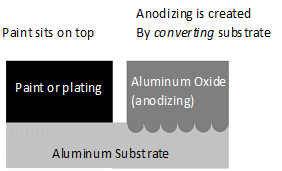
Anodizing is a Conversion Coating because the surface aluminum is converted into aluminum oxide. In the same way that charcoal on a charred fire log is integral to the log, the aluminum oxide layer is integral to the aluminum substrate.
The oxide coating is most commonly created by placing an aluminum part in a sulfuric acid bath while running a low-voltage DC current through the part to cathodes on the side of the tank. The part acts as the anode in the electrical circuit, hence the origin of the term “Anod-izing”.
Types of Anodizing
Most anodizing on machined parts are of two commonly specified types: Type II (or “regular”) sulfuric anodizing and Type III Hardcoat or “hard” sulfuric anodizing. The Type II & III designators come from the common Military specification, MIL-A-8625 (there is also a Type I anodizing, but this is done using environmentally-unfriendly chromic acid, and it is rarely specified these days).
Both Type II and Type III “hard” anodizing are very hard coatings. Type III “hard” anodizing is done at a lower temperature, is more expensive, and a little harder than Type II, but you need special equipment to tell the difference in practical terms. Type III, however, is much thicker than Type II, typically .002″ vs. .0006″ respectively, which makes it more resistant to scratching and heavy wear.
There is another type of anodizing, commonly called “architectural” anodizing. It is essentially the same as Type II anodizing above, but uses metallic ion dying which is completely colorfast in sunlight.
Anodize vs Alodine (Chem Film)
Alodine is a trade name for chemical conversion coating of aluminum (also called “chem film” or “chemical conversion coating”). Because the name sounds a bit like anodize, there is sometimes confusion between the two coatings. While both are conversion coatings, chem film is much thinner than anodizing and is alsocreated by immersion but without use of electrical current. Unlike anodizing, chem films (which are commonly seen in gold or ROHS clear versions) provide a conductive coating, and are sometimes used in conjunction with masking in anodized parts. The coating provides corrosion protection and also is an excellent base primer for paints. The common military specification for chemical conversion coating is MIL-DTL-5541.
Understanding coating thickness and build-up
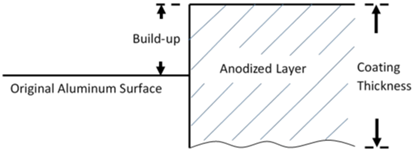
When specifying anodizing from a mechanical designer’s perspective, it is extremely important to understand the terms used by the anodizer, since these cause much confusion. Coating Thicknessis the actual thickness of the oxide layer. This is not the same as Build-up, which is a common term for t he dimensional difference between the oxide layer and the originally aluminum surface (see figure above).
Eddy current thickness testing meters are usually used to measure the anodized (oxide) layer. This will measure coating thickness, but not build-up. Build-up must be measured by comparing a finished part to an uncoated sample, or by calculation.
Calculating Build-up

Machining Tolerancing
With common Type II anodizing, the coating thickness will usually vary from .0002″ to .0012″. The thinnest coatings are usually seen in clear anodizing, since anodizing dyes require at least .0004″- .0006″ of coating thickness to dye properly. With an average coating thickness of .0008″, the build-up will typically be .0002″-.0003″, which is small enough that it can be effectively ignored in most machined and fabricated parts. This is not the case, however, with Type III, Hardcoat anodizing, which can have coating thicknesses of up to .004″, and build-up to .002″.
Threads, holes and masking
Even with thinner, Type II anodizing, coating build-up can cause problems with tolerancing, for example, with very fine threaded holes, precision pin holes, and fine sliding fits.
The most common solution to this problem is to mask the features. This is done using soft plastic plugs, for round holes, or plastic tape or painted-on liquid plastics for flat areas.
As noted above, masking is often not required for Type II anodizing. However, it should be noted on print call outs when specifying thicker Type III coatings and when small thread or tight tolerance features exist.
Silicon rubber plugs, such as these, are often used to mask high tolerance holes prior to anodizing.
Variation in Coating Thickness
While general coating thickness can be specified on a print, most anodizers will be leery of certifying an exact uniform coating thickness. This is because coating thickness will vary on a part due to part geometry, racking position, and the electrical field variations that inevitably exist in every anodizing tank. A variation of .0001-.0003 in coating thickness on a single part is common. While uniformity of thickness can be controlled to some degree by cathode placement, racking, and positioning in the tank, it is still as much an art as a science, and tight thickness tolerancing can be extremely expensive if even achievable.
Cost factors in Anodizing
Hard vs. regular anodizing:Since hard Type III anodizing is performed at a much lower temperature than regular Type II anodizing, and at higher current and voltage, it requires much higher energy use, and is usually considerably more expensive.
Masking:Masking usually involves a significant amount of hand work, which adds to cost. Masking materials often cannot be reused and add to costs as well.
Racking: Difficult-to-rack parts can add to cost. If needed, discuss adding racking features with your anodizer when needed on high-volume, low-cost parts.
Small features which trap chemistry:Small holes, especially blind holes, as well as small, deep pockets or other enclosed features force extensive rinsing of parts and raise labor costs.
Poor Specification:Poorly written or missing specifications on drawings mean more time spent on clarification and more cost. The more clearly the anodizing is defined on a drawing, with clear notes on racking, masking and other desired specifications, the better.
“Clear” Anodizing
“Clear” anodizing is really a misnomer, as undyed anodizing is not really clear. “Clear” anodizing varies from a very light gray for very thin coatings (.0001-.0003″) to a dark olive color for thick Type III coatings (.002 or greater). Very thin clear anodizing (sometimes called “cosmetic” clear) coatings mimic the look of bare aluminum (though the coating is actually slightly gray), hence the term “clear” anodizing. But on thick hardcoated parts, the coloring is anything but clear.
Both these parts are examples of undyed, “clear” anodizing, the only difference is the thickness of the anodizing!
The coating of these parts ranges from .0003″ on the left to greater than .002″ on the right- all are undyed.
Common Dyed Anodizing
An anodizing layer may be dyed or undyed. In the 8625 Mil spec, the term “Class” is used to designate this: Class 1 is clear or undyed, and Class 2 is dyed.
Anodizing layers are commonly dyed with organic dyes by dipping the part into a hot dye tank directly after anodizing. A wide variety of colors can be obtained through this process. By far the most commonly specified color is black, followed by blues, reds and golds. Note that only Type II anodizing can be dyed a variety of colors. Type III “hard” anodizing, which is quite dark even when undyed, is typically left clear or dyed black.
Photo: An example of anodized parts dyed red
Colors and Color Matching
The coating of these parts ranges from .0003″ on the left to greater than .002″ on the right- all are undyedIt is important to note that colors obtained through dying are not as consistent as those obtained through painting or powdercoat. There is no such thing as a pantone matched color in most commercial anodizing, and consistency in color and color matching is extremely difficult. Generally colors are specified in a broader way than with painting, e.g., you would specify “blue” or perhaps “light blue” or “dark blue” for an anodized part, not “deep sky blue” or “electric indigo blue”. Note that colors obtained through organic dyes are not absolutely colorfast, especially in high UV exposure situations. All organically dyed parts will fade to some degree over time. Outdoors, the fading can be dramatic.
Dying in Fade–resistant Architectural Anodizing
There is a second, less common dying process known as 2-step electrolytic dying. In this process, the anodizing layer is the same as regular Type II anodizing, but at the dying stage, instead of organic dyes, inorganic metallic dyes are used in combination with an electric current. While the range of colors is far more limited than with organic dyes (generally light through very dark, nearly black bronzes), the colors are extremely resistant to fading, and will last indefinitely even in very high UV environments.
Photo: Two black parts, after being placed in intense direct sunlight for approximately 8 months. Both parts started with a similar black color. The bottom part used common organic black dye and has noticeably faded. The top part was dyed using a 2-step electrolytic process (“architectural anodizing”) and shows no fading.
Defects in Metal and their Effects on Anodizing
Because anodizing is a conversion coating, and relies on the aluminum substrate being converted to aluminum oxide, any defects in the aluminum will have marked effects on the quality of the anodizing. The basic rule to remember is that the aluminum finish must be consistent, clean and fully exposed for the anodic layer to form properly.
Common problems occur with welds, extrusions, cold or hot-worked areas, or poorly machined surfaces.
It is common for problems in the material or mechanical finish to have the appearance of a problem with the anodizing. Often material defects will look like chemical spotting or streaking, when the issue is material based. GIGO (garbage in, garbage out) is truer with anodizing than nearly any other finish. For the anodic layer to be perfect, the aluminum substrate has to be perfect as well.
This blemish looks very much like a chemical spot, but it isn’t. It’s a location where a locating pin inadvertently pushed up the sheet metal. The sheet was peened back into place by the machinist, but the cold work altered the material enough to change the color of the anodizing.
This dark spotting looks like something amiss in the anodizing tank, but it was actually caused by overly dirty water in a vibratory tumbler. The dirty media was imbedded into the aluminum finish, causing blotchy areas.
Uncharacteristically, the welds on this bike frame caused little change in the anodizing color. However, poor sanding and left over spots of bondo create a surface finish that shows unanodized blotches and mechanical scratches.
Aluminum Alloys and their Effects on Anodizing Color
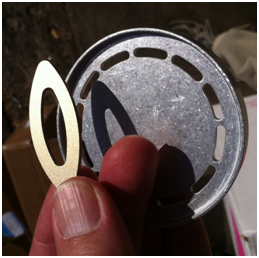
The smaller part on the left is machined from 7075, while the larger circular part is 6061. Note the distinctive yellowish tint of the left hand part, which is characteristic of clear anodizing of 7075 or 2024 alloys.
The Anodic Layer
Ever wondered why anodizing dyes so well? It has to do with the microscopic structure of the anodizing layer.
The oxide or “anodic” layer formed in the anodizing process consists of microscopic hexagonal oxide columns with holes or “pores” which extend nearly the entire length of each column. It is these pores which hold the dye.
The anodic layer is extremely hard- usually between 60-70 Rockwell C. The layer is also an excellent insulator, with a .002″hardcoat layer having a breakdown voltage of 1500-2000 volts.
The characteristic hexagonal structure of anodizing (hypothetically about 40,000x magnification). Note the hexagonal oxide columns have been sliced through to show the structure. An actual layer would be much thicker, with the height of the columns 200 or more times higher than their diameter.
The anodic layer grows outward from the aluminum surface as a part is anodized. As such, very sharp inside or outside corners on a part can cause gaps or voids to develop- especially with thick anodic layers such as Type III hardcoat anodizing. Avoid very sharp inside or outside corners when possible, and allow a radius of at least.015″(1/64th”).
Mil Spec MIL-A-8625
US Military Specification MIL-A-8625 is the most common specification for anodizing in use. Although the specification is somewhat out of date, especially in regards to the environmental impact of some of the processes (e.g., Type I chromic acid anodizing), it still is used as a model for much of the anodizing specified for military and aerospace products, and forms the basis for many proprietary company specifications.
The most common types and classes of anodizing found in MIL-A-8625 are:
- Type II Sulfuric Acid Anodizing (common or “standard” anodizing)
- Type III Sulfuric Acid Anodizing (hard or “hardcoat”anodizing)
- Class 1 – Undyed (clear)
- Class 2- Dyed (colored)
Note that MIL-A-8625 does not cover architectural anodizing, which is usually covered by a designation system provided by the Aluminum Association (e.g., AA-M12-C22-A34, for electrolytically dyed architectural anodizing).
As an example, a standard blackpart designated by MIL-A-8625 would be called out on a drawing as follows:
“MIL-A-8625, Type II, Class 2, black”
Understanding Racking and Rack Marks
Because anodizing involves running an electric current through the part to be anodized, parts must be gripped by conductive racks or wires. Where these racks or wires contact the part, there will be slight unanodized marks or “contact points” left on the surface of edges of the parts. MIL-A-8625 mentions and specifically allows for these rack marks.
Rack marks can be controlled by specifying on a drawing allowable locations for gripping a part. If rack marks are critical, discuss possible racking options in advance with your anodizer.
This photo shows several different racking approaches for parts of different sizes and shapes. Parts can be wired through holes, gripped on the edges, or gripped inside cavities with “spring” grippers. Anywhere there is metal to metal contact, there will be small unanodized areas.
Assemblies and Anodizing
In general, multi-part assemblies must be anodized before assembly. Because parts are dipped in both a strong alkaline (sodium hydroxide) and sulfuric acid, any studs, threaded inserts, pins, standoffs, etc., are in danger of corrosion and will cause problems in the anodizing tanks. Even stainless steel components can corrode in the tanks during anodizing, and can affect current flow during electrolytic processes. Gaps between components can also trap chemicals and cause problems by bleeding of the corrosives after anodize. As a rule of thumb- assemble after anodizing.
Testing if Clear Anodizing Exists
Since thin, “cometic” clear anodizing often mimics the look of bare aluminum, it is sometimes difficult to tell if a part has been anodized. Since anodizing is a strong insulator, an easy test is to use a volt-ohm meter set to measure resistance. Touch both probes to the metal part- if there is a high resistance, the part is most likely anodized.
Set a volt-ohm meter to measure resistance, and touch the probes to the surface of a part you suspect of being clear anodized. If there is high resistance, the part is likely anodized.
Marking and Engraving Anodizing
Anodizing is an excellent background finish for either mechanical or laser engraving. Using carbide tooling, e.g. a small 90ochamfer mill, letters, numbers or other symbols can engraved directly through the anodic layer with a CNC mill or router. The aluminum substrate gives an excellent contrast to the characters.
Laser Engraving also produces excellent results. Rather than burn through the anodic layer, a laser engraver will bleach the dye in the layer, generally giving an excellent contrast to the characters. An advantage of laser engraving on colored anodizing, is that no additional chemicals need be added to the surface to accentuate the marking, which is not the case with bare aluminum, stainless steel, or most other metals
An example of laser engraved characters on a black anodized part.
Care and Cleaning of Anodizing
Anodizing is surprisingly durable and resilient to corrosion. However, like its aluminum base, it is susceptible to strong alkalines, such as Lye or Sodium Hydroxide. It also can be damaged by strong acids, such as nitric or sulfuric. Beware of strong alkaline cleaners, which often contain ammonia or lye, as well as masonry or cement cleaners, which can contain strong acids.Surprisingly, anodizing is quite resistant to organic solvents. While alcohol or acetone will quickly remove ink from a permanent marker, for example, they will not damage or fade colored anodizing, and can be excellent for cleaning purposes.
Quick Designer Checklist:
- Specify type of anodizing, e.g., “Type II anodize” or “Type III hard anodize” to designate type of coating. The Mil spec may be included if desired, e.g., “Mil 8625, Type II anodize”. Specify color desired, e.g., “black”
- Examples of proper print call-outs:
- Type II anodize, black.
- Mil-A-8625, Type III, Clear (or Class I)
- Anodize, Type II, clear
- Anodize, Type III, Black
- Architectural Anodize, 2-step electrolytic, dark bronze.
- Examples of proper print call-outs:
- Think through whether masking will be required (especially with Type III hard anodizing). Call out masking locations on print.
- Remember to call out acceptable racking locations if racking marks are a concern.
For copies or permission to use this document, please contact OMW Corporation, 354 Bel Marin Keys Blvd., Novato, CA 94949. Ph. 415-382-1669.
References: Aluminum Anodizer’s Council. www.anodizing.org. The Aluminum Association, www.aluminum.org Credits: Most illustrations by author. Anodic Layer illustration by Joseph A. Osborn.
